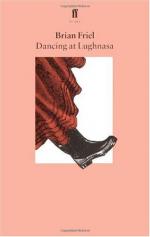|
This section contains 6,643 words (approx. 23 pages at 300 words per page) |

|
SOURCE: "Foregrounding the Body: The Plays of the 1990s," in The Art of Brian Friel: Neither Reality Nor Dreams, St. Martin's Press, 1995, pp. 208-62.
In the following excerpt, Andrews analyzes the "central image" of dancing in Dancing at Lughnasa.
In Dancing at Lughnasa (1990), the device of the boy / narrator allows memory to control and dominate the stage. Friel's dramatisation of nostalgic memory owes a good deal to Tennessee Williams's The Glass Menagerie, another play which is concerned with the tension between romance and reality. But whatever international influences there may be in Dancing at Lughnasa (Chekhov's and Lorca's ghosts are present too), Friel's concerns remain distinctively Irish—exploring the disposition for dreaming and mythologising which, as Hugh the schoolmaster in Translations explained to the Englishman Yolland, is a peculiarly Irish phenomenon. Williams's narrator is called Tom Wingfield, his name associating him with flight, as Friel's narrator, Michael, is...
|
This section contains 6,643 words (approx. 23 pages at 300 words per page) |

|


